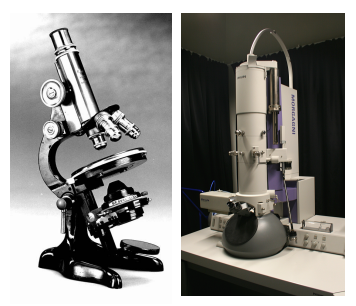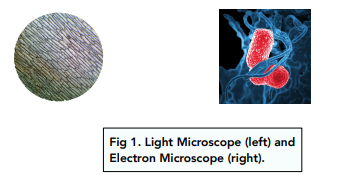Microscopes & Cultures - Microscopes (GCSE Biology)
Microscopes
Light and Electron Microscopes
- Cells can be seen with microscopes. Microscopes magnify small things that can’t usually be seen by the naked eye. This allows us to view cells within organisms
- Light microscopes were created first. Light microscopes have a magnification power of up to x2000. They use the beams of light and lenses in order to magnify a living object to create an image. They are cheap and portable and can be used to see cells and large organelles, or sub-cellular structures, such as nuclei.
- Electron microscopes changed the field of biology. Electron microscopes have a much higher magnifying power than light microscopes, and so could be used to see more sub-cellular structures, improving our understanding of biology.


Magnification and Resolution
- Resolution is the ability to tell the difference between two points. The greater the resolution of a microscope, the more detailed the image. In an image with a low resolution, two nearby objects may look like one.
- Magnification is the size of the image compared to the real size of the object. Magnification tells you how big an image is compared to the real object.
- Both resolution and magnification are important. Resolution is a key factor in the quality of an image taken by a microscope, whilst magnification determines the objects you can see. The higher the magnification of the microscope, the smaller the object that can be seen through it.
Electron microscopes
- Electron microscopes have a higher magnification. Electron microscopes provide a more magnified image than a light microscope. Electron microscopes use beams of electrons to make a magnified image. They have the magnifying power of around x2,000,0000.
- Electron microscopes also have a higher resolution. Electron microscopes also have a higher resolution, so provide a sharper image.
- But electron microscopes have drawbacks. However, electron microscopes are huge machines and are expensive, as they require specific operating conditions. Moreover, they can only be used to view non-living cells.
Light microscopes
Main parts of a light microscope you should be familiar with:
- Microscope slide – a clear plastic/ glass piece on which you mount your specimen being investigated
- Cover slip – this is a square clear plastic/ glass piece which goes on top of your specimen
- Stage – this is where you clip your microscope slide into place
- Eyepiece lens – this is the part of the microscope you look through
- Objective lens – these magnify the image and there are different types with different magnification levels
- Lamp – this shines light to the specimen so it can be seen more clearly
- Coarse/ Fine adjustment knobs – these help focus the image so it is clearer






Still got a question? Leave a comment
Leave a comment